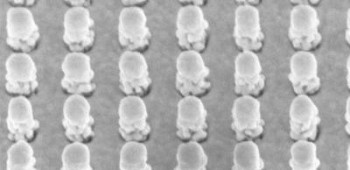The researchers at the Princeton University have made a breakthrough invention in the sensor technology by applying the Raman Scattering principle. The newly fabricated sensor is extremely sensitive; it is capable of detecting a host of substances from cancer cells to explosives.
This level of sensitivity has not been achieved so far by any sensor. This sensor identifies substances based on the colour of the light they reflect by scattering of the laser light emitted by that substance. It is capable of detecting very minute substances even the size of a single molecule. This advanced new architecture and design is the fruit of many years of research on how to apply Raman Scattering for material identification.
 Pillars on Raman-Sensing Chip
Pillars on Raman-Sensing Chip
Chandrasekhara Raman, an Indian physicist, discovered this phenomenon in the 1920’s. According to this, when a beam of monochromatic light is focused on a substance, the reflected light contains two extra colours of light. The frequency of these two colours speaks of the molecular structure of the substance. The application of this principle to everyday devices was however limited by the low strength of the emitted light.
Later, scientists came up with Surface Enhanced Raman Scattering (SERS), where the object to be identified was placed on a rough metal surface or on particles of gold or silver to enhance the strength of the signal. Even this was not really helpful as the emitted signal was scattered and hence difficult to measure.
Stephen Y. Chou is a professor of electrical engineering and led the research team, which discovered the new sensor. He explained that Raman sensors are by themselves weak, therefore his team devised a way to magnify the signal from the sensor, which resulted in the new ultra-sensitive sensor. Chou had electrical graduate students Wen-Di Li and Fei Ding, and post-doctoral fellow, Jonathan Hu for help in the research work. Their new chip is named “disk-coupled dots-on-pillar antenna-array”. The research findings were published in the Optics Express journal and Defence Advance Research Projects Agency funded the entire research.
The team looked at SERS with a fresh perspective and came up with a chip having identical rows of metals and insulators pillars. The pillars have two components namely a cavity formed by metal on top and base and metal particles (plasmonic nanodots) having a diameter of 20 nanometers on the pillar wall. There was a gap of two nanometres between the metal parts; this arrangement was able to boost the Raman signal. The metal cavities act as antennae and make the light pass through the plasmonic nanodots thereby the Raman signal is amplified many times.
Experiments are being conducted with less sensitive chips at the US Naval Laboratory in order to look into the possibility of using the chip fabricated at Princeton for chemical and biological agent detection. Another advantage the chip offers is manufacture in large sizes and quantities at a low price by using the nanoimprint method.
Source: http://www.princeton.edu/